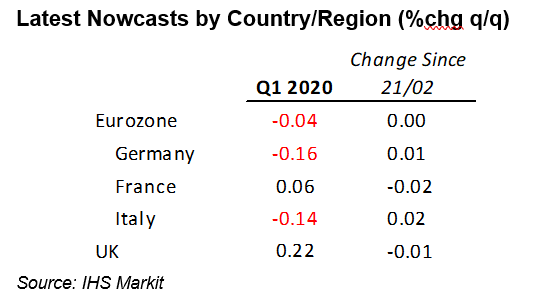Customer Logins
Obtain the data you need to make the most informed decisions by accessing our extensive portfolio of information, analytics, and expertise. Sign in to the product or service center of your choice.
Customer Logins
ECONOMICS COMMENTARY
Mar 04, 2020
IHS Markit European GDP Nowcasts: Underlying conditions across the Eurozone remain soft
Summary: 4th March 2020
Our latest GDP nowcasts across Europe are broadly unchanged from the previous update. The UK is set to be the stand-out performer across the advanced European economies in the first quarter, contrasting with modest contractions projected for Italy and Germany. France is expected to expand, although the underlying rate of growth appears only marginal.
With little in the way of new data for the euro area since our earlier estimate, the first quarter GDP nowcast remains broadly indicative of economic stagnation (-0.04%q/q). Regional estimates suggest that underlying conditions across the single currency area are set to soften since the end of last year.
Starting with France, our dynamic factor model predicts that the economy will return to growth in Q1, although the expansion is expected to be marginal (+0.06%q/q). Services firms recorded an accelerated, but moderate increase in output during February, although manufacturing production volumes slipped into contraction. We note that a rebound from the strong negative inventory drag in the fourth quarter has the potential to drive the official French GDP estimate much higher, but the main takeaway from our nowcast is that underlying growth has lost steam in 2020.
Italy on the other hand looks set to enter a technical recession. Although services activity grew at the quickest rate in four months during February, the COVID-19 outbreak in the northern parts of the country has started to disrupt activity. With this in mind, and manufacturing already in contraction, there is heightened downside risk to the Italy GDP nowcast as the economic impact becomes realised in the March PMI data.
While there is evidence that the manufacturing troubles which plagued the euro area, and particularly Germany, in 2019 have subsided, the negative supply- and demand-side shocks from the COVID-19 outbreak have ramped up downside risk to the first quarter economic performance. The demand-side drag so far has been exclusively from external markets, although February PMI data signalled the slowest growth in services activity for three months, providing tentative signs of negative impact on the domestic economy. Underlying PMI data showed the Hotels & Restaurants sector as the worst performer in terms of export demand, linked in part to reduced tourism. We retain our call that current underlying conditions in the German economy remain soft (nowcast: -0.16%q/q).
Finally, our Q1 UK GDP nowcast is once again broadly unchanged and points to a modest expansion of approximately 0.2% from the previous quarter. The sharp rebound in activity seen in January was followed up with another relatively strong growth outturn in February.
Next Nowcast Update: March 16th 2020
Joe Hayes, Economist, IHS Markit
Tel: +44 1491 461006
joseph.hayes@ihsmarkit.com
Paul Smith, Director, IHS Markit
Tel: +44 1491 461038
paul.smith@ihsmarkit.com
© 2020, IHS Markit Inc. All rights reserved. Reproduction in whole
or in part without permission is prohibited.
Purchasing Managers' Index™ (PMI™) data are compiled by IHS Markit for more than 40 economies worldwide. The monthly data are derived from surveys of senior executives at private sector companies, and are available only via subscription. The PMI dataset features a headline number, which indicates the overall health of an economy, and sub-indices, which provide insights into other key economic drivers such as GDP, inflation, exports, capacity utilization, employment and inventories. The PMI data are used by financial and corporate professionals to better understand where economies and markets are headed, and to uncover opportunities.
This article was published by S&P Global Market Intelligence and not by S&P Global Ratings, which is a separately managed division of S&P Global.
{"items" : [
{"name":"share","enabled":true,"desc":"<strong>Share</strong>","mobdesc":"Share","options":[ {"name":"facebook","url":"https://www.facebook.com/sharer.php?u=http%3a%2f%2fprod.azure.ihsmarkit.com%2fmarketintelligence%2fen%2fmi%2fresearch-analysis%2fihs-markit-european-gdp-nowcasts-underlying-conditions-across-the-eurozone-remain-soft-March20.html","enabled":true},{"name":"twitter","url":"https://twitter.com/intent/tweet?url=http%3a%2f%2fprod.azure.ihsmarkit.com%2fmarketintelligence%2fen%2fmi%2fresearch-analysis%2fihs-markit-european-gdp-nowcasts-underlying-conditions-across-the-eurozone-remain-soft-March20.html&text=S%26P+Global+European+GDP+Nowcasts%3a+Underlying+conditions+across+the+Eurozone+remain+soft+%7c+S%26P+Global+","enabled":true},{"name":"linkedin","url":"https://www.linkedin.com/sharing/share-offsite/?url=http%3a%2f%2fprod.azure.ihsmarkit.com%2fmarketintelligence%2fen%2fmi%2fresearch-analysis%2fihs-markit-european-gdp-nowcasts-underlying-conditions-across-the-eurozone-remain-soft-March20.html","enabled":true},{"name":"email","url":"?subject=S&P Global European GDP Nowcasts: Underlying conditions across the Eurozone remain soft | S&P Global &body=http%3a%2f%2fprod.azure.ihsmarkit.com%2fmarketintelligence%2fen%2fmi%2fresearch-analysis%2fihs-markit-european-gdp-nowcasts-underlying-conditions-across-the-eurozone-remain-soft-March20.html","enabled":true},{"name":"whatsapp","url":"https://api.whatsapp.com/send?text=S%26P+Global+European+GDP+Nowcasts%3a+Underlying+conditions+across+the+Eurozone+remain+soft+%7c+S%26P+Global+ http%3a%2f%2fprod.azure.ihsmarkit.com%2fmarketintelligence%2fen%2fmi%2fresearch-analysis%2fihs-markit-european-gdp-nowcasts-underlying-conditions-across-the-eurozone-remain-soft-March20.html","enabled":true}]}, {"name":"rtt","enabled":true,"mobdesc":"Top"}
]}





